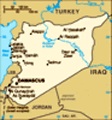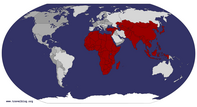Advertisement
Published: April 1st 2010
Salaam from Syria. We have had a fabulous week in Syria - home of some of the most friendly people we have ever met. Wherever we went people would always stop us to welcome us to Syria, ask where we are from and share out their delicious treats. Syria is nothing like we imagined and everyday Syrian life does not appear to be what is portrayed in the media. Our time in Syria was a very interesting history lesson.
The food is cheap and delicious, falafel wraps for only 40p, freshly squeezed orange juice from the street seller only 30p and loads of delicious hummus and the famous baba ghanoug (eggplant) and mansaf (chicken with rice with a delicious yoghurt sauce).
The border crossing from Turkey was pretty interesting. We first headed to Killis in Turkey where we changed from the bus and tried to organise a few cars. The cars were pretty rough, one of them had a shattered windscreen. When we got to the border all the fun began. Our car was ok but the last car could not get through and drove between Kallis and the border over again for about 2 hours because the driver’s
paperwork was not in shape. They then had to change cars. At the border, they really scrutinised our passports and everyone just pushed in all at once. Despite a sign saying no smoking, the immigration officials sat there and reviewed the passports with cigarettes hanging out of their mouths, ash spilling on our passports!
After about three hours everyone arrived and we then headed to Aleppo, which claims to be one of the oldest inhabited cities is the world and it was at the junction of the ancient trade route.
We wandered around the souq, everyone was so friendly and gave us things to try. We stumbled across the Al-Bimaristan Al-Argoni (Museum of Medicine and Science) which was established in 1354 AD. This was a former mental asylum where they used to perform scientific experiments on the patients. It was quite an eerie place not helped by the fact that they exhibited some barbaric looking medical equipment and awful scary looking mannequins which were set up in the rooms as a re-enactment.
Just as the sun was setting we headed into the mosque (Omayyad Mosque) which was founded in 715 AD, but all that is left now
dates from the 13th century (following a large earthquake) and is one of the biggest in the city. The minaret survived the earthquake and is still in its original form from 1090 - 1092 AD. It had a lovely courtyard where we could sit and people watch.
The citadel is the biggest and oldest monument in Aleppo and is set on a hill about 40m high in the middle of the city. It was originally used as a defence centre in 312 BC but what is left today dates from the 13th century AD. We sat up on the hill and overlooked the city during the morning call to prayer. Friday is the equivalent to Sundays for Christians and it is compulsory for Muslim men to go to the mosque. Listening to the call for prayer echoing around the city from the many minarets at the top of the citadel made us truly feel like we were in the Middle East. It was amazing.
Between Aleppo and Hama we stopped at Qala’at Samaan - the Basilica of St Simeon. Simeon was the son of a shepherd. He spent many years in a monastery before deciding to live in
a cave. News of his pious life spread and people came to him to be blessed. He got tired of the invasion to his privacy so he constructed a 3m high pillar for his residence. More and more people came for a blessing and the pillar therefore got higher and higher, up to 18m. It is claimed that he spent at least 40 years up there with monks bringing him food and water. A church was built around the pillar in 491 AD. It was a beautiful place with wild poppies growing over the ruins.
From there we headed to a dead city called Serjilla one of many ancient ghost towns in this area - they think at least 600 between Aleppo and Hama. It has been deserted for 15 centuries. No-one is 100% sure why the city was abandoned.
The next stop was Hama which is famous for its waterwheels which are dotted along the river. Unfortunately it is more well known for the massacre that occurred in 1982. It was hard to find any information as to what happened but from what we understand, during the 1930s the Muslim Brotherhood, called for a return to the
Quran. Over the years, the brotherhood strengthened. In the 1980’s they opposed the ruling Ba’ath Party and attempted to assassinate the leader. In retaliation, membership to the Brotherhood was banned and punishable by death. In 1982 they removed government ministers from their homes and declared Hama liberated. The government responded by sending in 8000 troops and shelling the city, destroying the citadel and old city. It is said that anywhere from 10,000 - 60,000 people were killed from a population of 350,000.
We then headed out east, towards the centre of Syria to Palmyra. We stopped along the way at the Krac des Chevalier (Castle of the Knights). The first fortress was built by the emir of Homs around 1031 AD and was later expanded into its present form during the Crusades, led by Richard the Lionheart. However, the fortress itself was never truly breached. In 1271 AD the Beybars marched onto the castle. This was one of the last outposts and the Christians were already retreating having lost Jerusalem. It was a huge castle, and in magnificent condition.
We stayed in Palmyra which is in the middle of the desert and famous for its ruins. Palmyra relies
heavily on tourism and the touts here were pretty bad. Motorbike after motorbike chased us through the ruins to sell jewellery, camel rides and scarves. They were harmless enough but pretty persistent.
The ruins date from the 2nd and 3rd century AD. So far they have uncovered about 50 acres of ruins, but they believe that at least 70% of the site remains uncovered. The most famous site is the Temple of Bel which was completed in AD 32. The number of columns in the area are amazing.
We also visited the Valley of the Tombs, a series of freestanding funerary towers or burial chambers, containing a series of pigeon hole like niches, stacked high, where the coffins were put. They were then sealed with a stone panel carved with a head and shoulders portrait of the deceased. As well as funerary towers, we also visited the Hypogeum of the Three Brothers, an underground burial chamber. The tomb dates from AD 160 to AD 91. There were some beautiful frescoes on the walls, pretty well preserved thanks to their underground home. The most preserved tomb, the Japanese Tomb, dates from AD 128. The carved busts and frescoes were
spectacular and one of the loculi even contained bones!
Our final stop in Syria was Damascus and we were very excited about visiting this city. However, about 20 minutes out of the city, on the main freeway, the public bus finally broke down and we had to try and flag down taxis. The taxi we got into did not know where he was going and we had to direct him with our map. He reversed down a really busy one way street, with permission of the traffic officer!
Damascus lays claim to be the oldest continuously inhabited city in the world. Legend has it that on a journey from Mecca, the Prophet Mohammed cast his gaze from the mountainside onto Damascus but refused to enter the city because he wanted to enter paradise only once, when he died.
We headed into the Souq Al-Hamidiyya. A vault of corrugated iron roofing blocks all light but a few shafts of sunlight are admitted through bullet holes punctured by the machine gun fire of French planes during the nationalist rebellion of 1925.
While in Damascus we had to find really tacky t-shirts for a dress up dinner. We secretly
had to buy these t-shirts, on a strict budget for someone else on the tour. The reason for the tacky and bad taste t-shirt competition relates to the fact the Syria is very much stuck in the 80s with fashion and there are some pretty hideous styles around. Even stranger is the extremely kinky lingerie which is around, its such a strange site watching women in burkhas purchasing lingerie (often men are the shopkeepers) which is dotted around the souq in full view of all.
We headed to the Umayyad Mosque, one of Islam’s important buildings. When the Muslims entered into Damascus in AD 636 they converted the eastern part into a mosque and let the Christians to continue their worship in the western part. This all changed under Umayyad rule and for the next 10 years a new mosque was built, using over 1000 stonemasons. It allegedly cost seven years of taxes from the whole of Syria to build. It has a beautiful large marble courtyard and inside the mosque there is a shrine of St John the Baptist - another place on this trip claiming to contain the remains of John the Baptist!
Interestingly, this was
our first time in a Mosque where we saw people wailing. It was mainly the women wailing at the shrine of Hussein, son of Ali and grandson of the Prophet. From what we can understand, the shrine attracts a large number of Shiite Muslims (Ali is regarded as the founder of Shiism) of which we think are of Iranian origin.
The wailing of both men and women was more prominent down the road at the Sayyida Ruqayya Mosque which is an Iranian mosque. The inside was amazing, not only for the wailing of the pilgrims but the roof inside the mosque was a riot of mirrored mosaics.
Next stop was Azem Palace which was built in AD 1749. It is a great example of a Damascene house, with a simple exterior which contrasts sharply with the interior courtyard, complete with fountains, citrus trees and jasmine. The interior rooms were beautifully decorated.
The girls headed out to a hammam. The hammam we went to was over 800 years old and not touristy at all! We walked in to find some very large naked women smoking and drinking tea. We were then taken by the hand into the hammam
proper and warm water was poured over us before being taken to sit in the sauna for half an hour or so before being individually led out for our scrub and massage. Having no idea what to expect (and obviously language was a problem, my Arabic being limited to hello, how are you and thanks) it was a slight shock to find my bikini top whipped off and thrown to the other side of the room, pushed flat on my back on the floor and the front of my body soaped and scrubbed by a very large half naked women with a very large bosom resting on the side of my face! It was much the same for the next 10 minutes or so! The other local women happily scrubbed each other, chatted and shared food. When we came out, the women were back in their burkhas praying. Very interesting but I am not sure if I would rush back!
Next stop Jordan.
Advertisement
Tot: 0.487s; Tpl: 0.02s; cc: 18; qc: 99; dbt: 0.3309s; 1; m:domysql w:travelblog (10.17.0.13); sld: 1;
; mem: 1.3mb




















